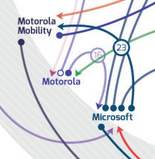| Microsoft's Patent Tracker Goes Live |
| Written by Sue Gee |
| Monday, 01 April 2013 |
|
Microsoft has delivered the facility it promised us a few weeks ago in order to provide a degree of transparency into the patents held by the company and its subsidiaries. Patent Tracker is a list of all its patents, including those for utility, design, and utility models. Back in February Mircosoft's General Counsel & Executive Vice President, Legal & Corporate Affairs, Brad Smith, pledged that by April 1st the company would: "publish on the web all the information that anyone needs to identify all of the patents for which Microsoft is the owner and the real party of interest". Perhaps someone pointed out to him that the choice of April 1st sent all the wrong signals in that some might interpret it a joke, so the timing was adjusted so that Patent Tracker went live on March 28th. Interestingly Microsoft relied on an external source for the data to populate Patent Tracker list. Microsoft generated the list of patent numbers and related information (Patent Title, Region and Assignee) was procured from the Thomson Reuters IP database. According to Microsoft this was to ensure that the information was accurate and matched the data presented in publicly available databases. Official patent records include some typographical errors (in both title and assignee fields) and these are replicated in the Thomson Reuters data. There are two facilities offered by the Patent Tracker database. Users can search by patent number, patent title (or words and phrases within a patent title), country and whether the patent is held by Microsoft or a subsidiary. Or they can download a CSV file containing the entire list in order to use a spreadsheet for deeper analysis. Although the results show patent titles in blue these are not links to the parents. If you want to find out more you'll need to search a patent database and Microsoft suggests he US Patent and Trademark Office's general Patent Search home page and the European Patent Office’s search site. For US patent's Google Patents is also useful but oddly enough Microsoft doesn't include this link.
Writing in the Technet blog, and also in the video below introducing Patent Tracker, Brad Smith extols the virtue of providing transparency Transparency around patent ownership will help prevent gamesmanship by companies that seek to lie in wait and “hold up” companies rather than enable a well-functioning secondary market. Of equal importance, transparency is a prerequisite to enforceability of patent licensing pledges, whether to standards bodies or to the world at large. Quite simply, without transparency it is impossible to determine if a company is in fact abiding by those commitments.
Transparency is just one of the principles Smith advocates. In an earlier bolg post he also makes the following arguments:
If big companies can lead the way of all of these maybe we will see a reduction in the time and energy devoted to patent wars. Portion of a Patent Wars Infographic shows Microsoft an active contender/defender, see more here. More InformationEnhancing Transparency: Putting Microsoft's Patents on the Web Related ArticlesFind Prior Art Added to Google Patent Search Patent Office Invalidates Apple's Rubber-banding Patent Apple's Win Over Samsung - What Next Apple v Samsung Galaxy Nexus: A Programmer Reads the Patents
To be informed about new articles on I Programmer, install the I Programmer Toolbar, subscribe to the RSS feed, follow us on, Twitter, Facebook, Google+ or Linkedin, or sign up for our weekly newsletter.
Comments
or email your comment to: comments@i-programmer.info
|
| Last Updated ( Monday, 01 April 2013 ) |


